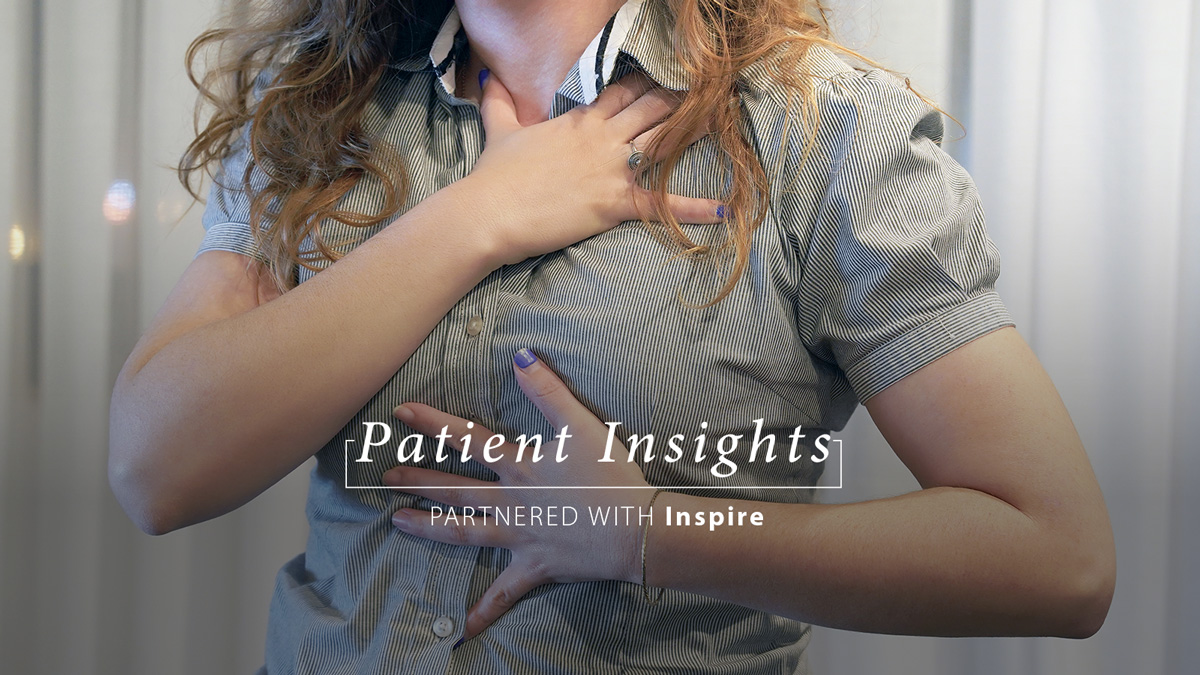Words matter during a heart attack

Recent research suggests that the ways in which men and women describe heart attack symptoms differently can affect diagnosis in urgent situations. Heart attack survivor and patient advocate Maggie Parke tells us her story.
Everyone who knows me and has worked with me knows I can be outspoken. I wear my emotions on my sleeve and am not afraid to speak up. Why I didn’t speak up on a Saturday in April 2015 will always haunt me.
I had been hiking the same dunes near my house for years in Western MI with my neighbour Carla. This particular week I was trying to push myself before a long trip to San Francisco for a client. Saturday morning, a day before a five hour flight, I really pushed myself. Something was off that day, and I didn’t feel quite right. At the end of my hike, I waited for Carla to finish hers and sat down. I was red in the face, and couldn’t concentrate. On our way down, I collapsed, a sharp pain running through my chest that came and went quickly. It seemed odd, but I didn’t give it a second thought. I must have pulled a muscle.
At home, I took a shower, fading in and out of consciousness – something that didn’t faze me at all. After that, I threw up for four straight hours. I chalked it up to the fact that I overdid it on my hike. It had to be exertion as I had hiked over 11.5 miles in two days. Then I was uncomfortable – the word I will always regret using. I couldn’t get comfortable and was writhing away on the bedroom floor for hours. I still thought I had pulled a muscle and just kept trying to get in a position of relief. Then, an impending sense of doom came over me, and I knew something was wrong. I asked my husband to take me to the local urgent care. Two years prior, he had similar symptoms, which turned out to be an allergic reaction. That had to be it – I was 42 at the time and thought I was healthy – it was an allergic reaction.
“What I was experiencing wasn’t pain; it was pressure and cramping that moved and came and went. I would never have thought to describe it as pain”
We arrived at urgent care, and I sat up against the wall waiting to check-in. My husband said, “You have to use the touch screen to enter your info”. I tried to put in my info, and then it asked if I was suffering chest pain. I said, “No.” I was extremely uncomfortable; it wasn’t what I considered to be pain. Pain, to me, was a throbbing, direct source of pain. What I was experiencing wasn’t pain; it was pressure and cramping that moved and came and went. I would never have thought to describe it as pain.
I was sent to wait it out in the waiting room. As I was waiting to hear my name called, I couldn’t sit still. I was on my knees, huddled over the chair, trying to get comfortable, and it wasn’t working.
Fifteen minutes later, I had been called to the nurse's station. I said, “I am really uncomfortable.” The response was, “You must be having a panic attack or an asthma attack.” I said “I don’t have asthma, and I’m not panicked” as I squirmed all over their desk, trying to soothe myself from this unpleasant sensation in my chest. I could not sit still. They finally took me back to a room and asked more questions. They had placed an oxygen sensor on my finger and concluded it wasn’t working. They tried two more, still not working. Another five minutes went by, and they did an EKG. Afterwards, a doctor came back, and calmly said: “Margaret, you are having a heart attack.” My husband jumped up as my jaw dropped. No wonder the oxygen sensors didn’t work – I was in impending cardiogenic shock.
An ambulance ride took me to the ER; I felt like there were octopus arms all over me. What seemed to take forever really only took eight minutes before I went to the cath lab. My ‘heart attack’ was pretty bad, bad enough that they stuck two chaplains on my husband, who kept telling him, “You have to be prepared.” The interventional cardiologist kept yelling, “You should have come in earlier” and “This is significant.” All this time, I was still in shock.
I had clots in my left ascending artery, 100% blocked, a condition known as the ‘widowmaker.’ The clots were from a SCAD (Sudden Coronary Artery Dissection), a condition where a tear forms in a blood vessel in the heart, releasing blood which can clot and obstruct other vessels. I was in cardiogenic shock and had many runs of ventricular fibrillation. The interventional cardiologist put two stents in and a balloon to help my failing heart pump blood, a precaution taken when they believe you will go into complete heart failure. For two days, I lay flat on my back in the ICU, still in shock of what had just happened with a balloon in my chest. With each beat of my heart, I could hear the balloon, made of some crunchy material help pump blood out of my left ventricle. Six days later, I was home, still in shock and disbelief about what had happened.
Fast forward a few months. My husband and I moved to Boston to be closer to family. I also wanted to be closer to some of the best hospitals in the world. A childhood friend set me up with an amazing cardiologist who has cared for me since we moved. My heart has never fully recovered, and I had an internal cardiac defibrillator implanted. My heart is not strong enough to stop potentially fatal arrhythmias so the implantable cardioverter defibrillator (ICD) will shock me out of any bad conditions.
When you’ve been through a life-changing event, you tend to continue to replay the events in your head, partly to cope, and partly to figure out what you could have done differently. For months and years, I thought, “I had atypical symptoms,” something commonly said of women who experience heart attacks. The Mayo clinic even segregates out “women symptoms” vs. men stating that women may experience different symptoms. But did I? Or did I not describe my symptoms well enough to get immediate attention by healthcare professionals?
There is a lot of research and stories about how women are not afforded the same sense of urgency as men in critical health situations. A recent AI study suggested that men and women present their symptoms differently when experiencing a cardiac event. The study, done by Harvard school of public health, studied the words used by both men and women to describe heart attack symptoms. The conversations between patients and doctors in over 600 patients, both men and women, describing angina pain from suspected coronary artery diseases yielded interesting results. Using machine learning to study the symptoms presented showed that women and men tended to have the same symptoms, yet described the symptoms differently which were interpreted differently by physicians.
“The terms typical and atypical angina should be abandoned, as they do not correlate with disease and may perpetuate stereotypes based on sex,” researchers presenting findings on the HERMES trial on Sept. 2 during ESC Congress 2019 have said.
My husband and I both went to the same urgent care, two years apart, with similar symptoms. He walked in and said he was having chest pain and was immediately taken back for an EKG. He was having an allergic reaction, not a heart attack. I said I was uncomfortable and nauseous, and I was told to wait in the waiting area. It took about 20 minutes from the time that I arrived to have an EKG. I was too passive. Afraid to express the fact that I didn’t feel well and something was wrong, really wrong. I am never passive in work and my personal life – but that day, I was.
It is often reported that heart attacks remain more deadly in women than in men. These results could be partly due to how women describe their symptoms and, ultimately, how the physicians interpret them which dictates the next course of care.
I have since had two friends in their 40s experience heart attacks. When describing their pain, uncomfortable is the best way to describe it. Uncomfortable meaning you cannot get comfortable, no matter what position you try. I also still use this word when telling others what I felt.
I have become much more direct these days and choose my words wisely when I know something is wrong. I don’t sway on the low side on the 1-10 pain scales. If I’m in pain or experience a very unsettling and uncomfortable symptom, I always rate it on the pain scale. I have become much more direct when describing my symptoms.
I also encourage others to be their own advocate – if something is wrong, make sure the doctors know that. Within my own patient-led Congestive Heart Failure group, we often comment on our experiences in the clinical setting. We seek to help guide and facilitate those conversations based on our own experiences whether it be for an emergency or routine checkup. As we always say “never underestimate your symptoms.”
About the author
Maggie Parke, Ph.D., is a SCAD and heart attack survivor living with her husband in Boston, MA. She is a co-founder of a private Congestive Heart Failure group on Facebook and www.mybeatgoeson.org, a website to further support the heart failure community with information put together by the group.
 Patient Insights is a monthly series that appears in partnership with Inspire, a company with an online support community of more than 2 million patients and caregivers worldwide.
Patient Insights is a monthly series that appears in partnership with Inspire, a company with an online support community of more than 2 million patients and caregivers worldwide.











